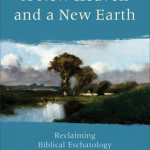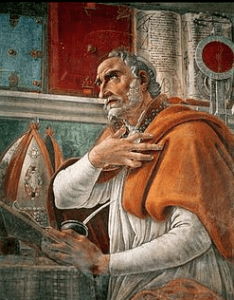 Karl Giberson has a new book out, The Wonder of the Universe: Hints of God in Our Fine-Tuned World, published by IVP. I received a copy of the book courtesy of the publisher awhile back and have begun to read it over the last few days. This book is a description of the wonder of our universe and of the process of discovery that led to our modern understanding of the universe. It is an excellent book for a general audience – college educated perhaps (although high school students may like it as well), but with little understanding of science required. Although I will not post through the book chapter by chapter, I will put up a few posts on the topics covered by this book.
Karl Giberson has a new book out, The Wonder of the Universe: Hints of God in Our Fine-Tuned World, published by IVP. I received a copy of the book courtesy of the publisher awhile back and have begun to read it over the last few days. This book is a description of the wonder of our universe and of the process of discovery that led to our modern understanding of the universe. It is an excellent book for a general audience – college educated perhaps (although high school students may like it as well), but with little understanding of science required. Although I will not post through the book chapter by chapter, I will put up a few posts on the topics covered by this book.
In the first four chapters of the book Giberson discusses the history of the science that led from the understanding of cosmology with a flat earth on pillars covered by spheres with the lights of the heavens to the modern theory of general relativity and big bang. Giberson is an excellent writer and tells a fascinating story. This story emphasizes the way science progresses with new observations and new capabilities leading to new hypotheses and better understanding but always building off of what had come before.
How do you understand the process and progress of science?
The ancient understanding of the world was entirely empirical – the natural appearance was assumed to represent reality. The earth is flat, the sun, moon, and stars contained in a solid firmament rise and set each day. Waters contained above occasionally fall and water below can rise up through springs. The description of Noah’s flood in Genesis reflects this understanding of the world:
In the six hundredth year of Noah’s life, on the seventeenth day of the second month—on that day all the springs of the great deep burst forth, and the floodgates of the heavens were opened. And rain fell on the earth forty days and forty nights. (Gen. 7:11-12)
Now the springs of the deep and the floodgates of the heavens had been closed, and the rain had stopped falling from the sky. The water receded steadily from the earth. (Gen. 8:2-3a)
The image in Giberson’s book (also found in numerous places on the web, so I am not sure of the precise attribution) gives an idea of the general view that was commonly held and underlies the story:
This view of the world gradually changed, beginning as early as 500 BC as Giberson tells us.
Around 500 B.C. Pythagoras – of the beloved math theorem about triangles – thought long and hard about the odd appearance of the moon as it went through its phases. The line separating the dark and light parts of the moon had an interesting shape that could only be explained only by assuming that the moon was round. Pythagoras then took a speculative leap and concluded that the earth must be the same shape as the moon. (p. 25)
Within 100 years eclipses were understood and …
By 350 B. C. there was a consensus that the earth is a sphere. Aristotle noted that seafaring travelers reported seeing different constellations as they traveled farther and farther from the equator. (p.26)
Observations of the world around us and the heavens above (or around) led to a better understanding of the nature of the world. Each generation, building on the accumulated knowledge of preceding generations accompanied by better observations spanning a broader range of experience, expanded the depth of understanding and explanation. In the early years of the Christian church the general view was Aristotelian with a spherical earth surrounded by concentric circles containing the moon, planets, sun, and stars.
From the consensus of a spherical earth Giberson leaps forward some 1800 years to Copernicus (1473-1543) and his hypothesis that the earth moves around the sun, Galileo (1564-1642) and the telescope he used to study the heavens, Newton (1643-1727) and the theory of gravity, the discovery of Neptune and the anomalous orbit of Mercury, Einstein (1879-1955) and general relativity moving beyond Newton’s theory and explaining the precession of Mercury, the big bang and the expanding universe. The tale of scientific discovery and consensus building is fascinating. Dr. Giberson does an excellent job of explaining the way science works, moving forward in both tiny steps and larger leaps grounded in the interplay between observation and explanatory theories.
The conflict surrounding Galileo. Working through the gradual acceptance of a sun-centered solar system Giberson makes some interesting observations about the famous – or better, infamous – case of Galileo.
The word fools, unfortunately, was often on Galileo’s lips as he enthusiastically ridiculed those who disagreed with him.
Galileo’s advocacy for Copernicanism grew with each passing year, despite his consistent failure to find the evidence he promised, He became bolder and more aggressive. His fame spread across the continent and he grew steadily richer, with increasingly more lucrative academic postings and endless sales of telescopes. Gifted at debate and self-promotion, he steadily climbed the Italian social ladder, to the envy of his colleagues. He made enemies and backed many of his critics into corners from where they could do nothing but seethe and look for an opportunity to get even. Some more cool-headed Jesuit astronomers were quietly teaching Copernican astronomy in Catholic universities, and, had Galileo not turned the motion of the earth into a political controversy, their diplomatic approach would have probably carried the day and avoided what became a great humiliation to the church. As it was, they were quite frustrated that Galileo’s bombastic personal style got Copernicanism declared heretical and his book listed on an Index and Prohibited Books that good Catholics were not supposed to read.
…had Galileo been more diplomatic there would not have been any need or his great and celebrated confrontation between science and religion. (p. 52-53).
The story of Galileo is an interesting one – and the lesson well worth learning. The lesson isn’t that the church is a recalcitrant stick in the mud, valuing tradition over truth, or that Christianity is a hindrance to the progress of science and human understanding. Rather the lesson is one of psychology and sociology. History is littered with the casualties of arrogance and self-promotion (unfortunately not always the arrogant self-promoter).
Does this view of the conflict between Galileo and the Catholic church surprise you?
How should we approach new ideas and controversial ideas?
If you wish to contact me directly, you may do so at rjs4mail[at]att.net
If interested you can subscribe to a full text feed of my posts at Musings on Science and Theology.












